All Exams >
Humanities/Arts >
Geography Class 11 >
All Questions
All questions of World Climate and Climate Change for Humanities/Arts Exam
Direction: Read the case study given below and answer any three of the questions that follow.The causes for climate change are many. They can be grouped into astronomical and terrestrial causes. The astronomical causes are the changes in solar output associated with sunspot activities. Sunspots are dark and cooler patches on the sun which increase and decrease in a cyclical manner. According to some meteorologists, when the number of sunspots increase, cooler and wetter weather and greater storminess occur. A decrease in sunspot numbers is associated with warm and drier conditions. Yet, these findings are not statistically significant. Another astronomical theory is Milankovitch oscillations, which infer cycles in the variations in the earth’s orbital characteristics around the sun, the wobbling of the earth and the changes in the earth’s axial tilt. All these alter the amount of insolation received from the sun, which in turn, might have a bearing on the climate. Volcanism is considered as another cause for climate change. Volcanic eruption throws up lots of aerosols into the atmosphere. These aerosols remain in the atmosphere for a considerable period of time reducing the sun’s radiation reaching the Earth’s surface. After the recent Pinatubo and El Cion volcanic eruptions, the average temperature of the earth fell to some extent for some years. The most important anthropogenic effect on the climate is the increasing trend in the concentration of greenhouse gases in the atmosphere which is likely to cause global warming.Q. A decrease in sunspot numbers is associated with ______ and ______ conditions.- a)warm; wet
- b)warm; drier
- c)cold; humid
- d)cold; drier
Correct answer is option 'B'. Can you explain this answer?
Direction: Read the case study given below and answer any three of the questions that follow.
The causes for climate change are many. They can be grouped into astronomical and terrestrial causes. The astronomical causes are the changes in solar output associated with sunspot activities. Sunspots are dark and cooler patches on the sun which increase and decrease in a cyclical manner. According to some meteorologists, when the number of sunspots increase, cooler and wetter weather and greater storminess occur. A decrease in sunspot numbers is associated with warm and drier conditions. Yet, these findings are not statistically significant. Another astronomical theory is Milankovitch oscillations, which infer cycles in the variations in the earth’s orbital characteristics around the sun, the wobbling of the earth and the changes in the earth’s axial tilt. All these alter the amount of insolation received from the sun, which in turn, might have a bearing on the climate. Volcanism is considered as another cause for climate change. Volcanic eruption throws up lots of aerosols into the atmosphere. These aerosols remain in the atmosphere for a considerable period of time reducing the sun’s radiation reaching the Earth’s surface. After the recent Pinatubo and El Cion volcanic eruptions, the average temperature of the earth fell to some extent for some years. The most important anthropogenic effect on the climate is the increasing trend in the concentration of greenhouse gases in the atmosphere which is likely to cause global warming.
Q. A decrease in sunspot numbers is associated with ______ and ______ conditions.
a)
warm; wet
b)
warm; drier
c)
cold; humid
d)
cold; drier
|
|
Ojasvi Mehta answered |
Sunspots are areas where the magnetic field is about 2,500 times stronger than Earth's, much higher than anywhere else on the Sun. This in turn lowers the temperature relative to its surroundings because the concentrated magnetic field inhibits the flow of hot, new gas from the Sun's interior to the surface.
Warm temperate climates extend from:- a)300 500 latitude
- b)40 50 latitude
- c)35 40 latitude
- d)450 50 latitude
Correct answer is option 'A'. Can you explain this answer?
Warm temperate climates extend from:
a)
300 500 latitude
b)
40 50 latitude
c)
35 40 latitude
d)
450 50 latitude
|
|
Samridhi Chavan answered |
It is mainly on eastern and western margins of continents.
With reference to the Tropical Savannah Region, consider the following statements:1. It is found to the north and south of tropical rainforest biomes.2. The largest expanses of savanna are in Africa, where much of the central part of the continent, for example, Kenya and Tanzania, consists of tropical grassland.3. Savanna grasslands can not be found in Brazil in South America.How many of the statements given above are correct?- a)Only one
- b)Only two
- c)All three
- d)None
Correct answer is option 'B'. Can you explain this answer?
With reference to the Tropical Savannah Region, consider the following statements:
1. It is found to the north and south of tropical rainforest biomes.
2. The largest expanses of savanna are in Africa, where much of the central part of the continent, for example, Kenya and Tanzania, consists of tropical grassland.
3. Savanna grasslands can not be found in Brazil in South America.
How many of the statements given above are correct?
a)
Only one
b)
Only two
c)
All three
d)
None
|
|
Pj Commerce Academy answered |
Tropical Savannah Region
- It is also known as tropical grasslands - which are found to the north and south of tropical rainforest biomes. Hence, Statement 1 is correct.
- It is also known as Tropical wet and dry in the Koeppen classification.
- The largest expanses of savanna are in Africa, where much of the central part of the continent, for example, Kenya and Tanzania, consists of tropical grassland. Hence, Statement 2 is correct.
- Savanna grasslands can also be found in Brazil in South America. Hence, Statement 3 is not correct.
- Savanna regions have two distinct seasons - a wet season and a dry season.
- There is very little rain in the dry season.
- In the wet season, vegetation grows, including lush green grasses and wooded areas.
- As you move further away from the equator and its heavy rainfall, the grassland becomes drier and drier - particularly in the dry season.
Savanna vegetation includes scrub, grasses, and occasional trees, which grow near water holes, seasonal rivers or aquifers.
The type of climate portrayed by Plateau Station, Antarctica is- a)Dw.
- b)ET.
- c)EF.
- d)Df.
Correct answer is option 'C'. Can you explain this answer?
The type of climate portrayed by Plateau Station, Antarctica is
a)
Dw.
b)
ET.
c)
EF.
d)
Df.
|
|
Gayatri Yadav answered |
The ice cap climate or ‘EF’ occurs in this region. It is the polar climate. Even in summer, the temperature is below freezing point. This area receives very little precipitation. The snow and ice gets accumulated and the mounting pressure causes deformation of the ice sheets and they break.
Which one of the following cause global warming?- a)Carbon dioxide
- b)Oxygen
- c)Nitrogen
- d)Hydrogen
Correct answer is option 'A'. Can you explain this answer?
Which one of the following cause global warming?
a)
Carbon dioxide
b)
Oxygen
c)
Nitrogen
d)
Hydrogen
|
|
Meera Choudhary answered |
About 75% of the solar energy reaching the earth is absorbed by the earth’s surface the rest of the heat radiate back to the atmosphere. Some of the heat is trapped by greenhouse gases as carbon dioxide which is released by various human activities.
The GHG that results from the intestinal gases of ruminants (cows) is- a)Nitrous oxide
- b)Carbon dioxide
- c)Carbon monoxide
- d)Methane
Correct answer is option 'D'. Can you explain this answer?
The GHG that results from the intestinal gases of ruminants (cows) is
a)
Nitrous oxide
b)
Carbon dioxide
c)
Carbon monoxide
d)
Methane
|
|
Upasana Chopra answered |
Methane was discovered and isolated by Alessandro Volta between 1776 and 1778 when studying marsh gas from Lake Maggiore. Methane is a relatively potent greenhouse gas. Compared with carbon dioxide, it has a high global warming potential of 72 (calculated over a period of 20 years) or 25 (for a time period of 100 years). Methane also affects the degradation of the ozone layer.
In which of the following periods earth’s climate was not warm?- a)Cambrian
- b)Ordovician
- c)Silurian
- d)Hercynian
Correct answer is option 'D'. Can you explain this answer?
In which of the following periods earth’s climate was not warm?
a)
Cambrian
b)
Ordovician
c)
Silurian
d)
Hercynian
|
|
Lekshmi Chakraborty answered |
Hercynian denoting a prolonged mountain-forming period in western Europe, eastern North America, and the Andes in the Upper Palaeozoic era, especially the Carboniferous and Permian periods.
Polar climates are denoted by- a)P.
- b)E.
- c)F.
- d)G.
Correct answer is option 'B'. Can you explain this answer?
Polar climates are denoted by
a)
P.
b)
E.
c)
F.
d)
G.
|
|
Roshni Patel answered |
Polar climates exist poleward beyond 70° latitude. Polar climates consist of two types: (i) Tundra (ET); (ii) Ice Cap (EF).
The type of climate found in the Amazon basin in South America is tropical- a)monsoon climate.
- b)dry climate.
- c)wet climate.
- d)wet and dry climate.
Correct answer is option 'C'. Can you explain this answer?
The type of climate found in the Amazon basin in South America is tropical
a)
monsoon climate.
b)
dry climate.
c)
wet climate.
d)
wet and dry climate.
|
|
Devanshi Choudhary answered |
This area is near the equator. Significant amount of rainfall occurs in every month of the year as thunder showers in the afternoon.
BWh denotes:- a)Sub-tropical Steppe climate
- b)Sub-tropical desert climate
- c)Mid latitude Steppe climate
- d)Mid latitude desert climate
Correct answer is option 'B'. Can you explain this answer?
BWh denotes:
a)
Sub-tropical Steppe climate
b)
Sub-tropical desert climate
c)
Mid latitude Steppe climate
d)
Mid latitude desert climate
|
|
Athul Ghosh answered |
Sub-tropical Desert Climate (BWh) is located in the transition zone between humid and dry climates,
Direction: Read the case study given below and answer any three of the questions that follow.The causes for climate change are many. They can be grouped into astronomical and terrestrial causes. The astronomical causes are the changes in solar output associated with sunspot activities. Sunspots are dark and cooler patches on the sun which increase and decrease in a cyclical manner. According to some meteorologists, when the number of sunspots increase, cooler and wetter weather and greater storminess occur. A decrease in sunspot numbers is associated with warm and drier conditions. Yet, these findings are not statistically significant. Another astronomical theory is Milankovitch oscillations, which infer cycles in the variations in the earth’s orbital characteristics around the sun, the wobbling of the earth and the changes in the earth’s axial tilt. All these alter the amount of insolation received from the sun, which in turn, might have a bearing on the climate. Volcanism is considered as another cause for climate change. Volcanic eruption throws up lots of aerosols into the atmosphere. These aerosols remain in the atmosphere for a considerable period of time reducing the sun’s radiation reaching the Earth’s surface. After the recent Pinatubo and El Cion volcanic eruptions, the average temperature of the earth fell to some extent for some years. The most important anthropogenic effect on the climate is the increasing trend in the concentration of greenhouse gases in the atmosphere which is likely to cause global warming.Q. What are dark and cooler patches on the sun which increase and decrease in a cyclical manner called?- a)Sunsets
- b)Sunrise
- c)Sunspots
- d)Sun gaps
Correct answer is option 'C'. Can you explain this answer?
Direction: Read the case study given below and answer any three of the questions that follow.
The causes for climate change are many. They can be grouped into astronomical and terrestrial causes. The astronomical causes are the changes in solar output associated with sunspot activities. Sunspots are dark and cooler patches on the sun which increase and decrease in a cyclical manner. According to some meteorologists, when the number of sunspots increase, cooler and wetter weather and greater storminess occur. A decrease in sunspot numbers is associated with warm and drier conditions. Yet, these findings are not statistically significant. Another astronomical theory is Milankovitch oscillations, which infer cycles in the variations in the earth’s orbital characteristics around the sun, the wobbling of the earth and the changes in the earth’s axial tilt. All these alter the amount of insolation received from the sun, which in turn, might have a bearing on the climate. Volcanism is considered as another cause for climate change. Volcanic eruption throws up lots of aerosols into the atmosphere. These aerosols remain in the atmosphere for a considerable period of time reducing the sun’s radiation reaching the Earth’s surface. After the recent Pinatubo and El Cion volcanic eruptions, the average temperature of the earth fell to some extent for some years. The most important anthropogenic effect on the climate is the increasing trend in the concentration of greenhouse gases in the atmosphere which is likely to cause global warming.
Q. What are dark and cooler patches on the sun which increase and decrease in a cyclical manner called?
a)
Sunsets
b)
Sunrise
c)
Sunspots
d)
Sun gaps
|
|
Deepika Reddy answered |
Sunspots: Dark and Cooler Patches on the Sun
Sunspots are dark and cooler patches on the sun that increase and decrease in a cyclical manner. These sunspots are regions on the sun's surface that appear dark because they are cooler compared to the surrounding areas.
Cyclical Nature of Sunspots
- Sunspots follow a cyclical pattern, with their numbers varying over an approximately 11-year solar cycle.
- During periods of high solar activity, there are more sunspots visible on the sun's surface.
- Conversely, during periods of low solar activity, the number of sunspots decreases.
Influence on Weather and Climate
- Some meteorologists believe that changes in sunspot activity can affect Earth's weather and climate.
- An increase in sunspot numbers may be associated with cooler, wetter weather, and greater storminess.
- Conversely, a decrease in sunspot numbers may lead to warmer and drier conditions.
Statistical Significance
- While there are theories linking sunspots to changes in weather and climate, the statistical significance of these relationships is not always clear.
- More research is needed to fully understand the impact of sunspots on Earth's climate.
In conclusion, sunspots are important astronomical phenomena that can potentially influence Earth's weather and climate, although the exact mechanisms and significance of this relationship are still being studied.
The group of four climates that represent humid conditions is- a)A-B-C-E.
- b)A-C-D-E.
- c)B-C-D-E.
- d)A-C-D-F.
Correct answer is option 'B'. Can you explain this answer?
The group of four climates that represent humid conditions is
a)
A-B-C-E.
b)
A-C-D-E.
c)
B-C-D-E.
d)
A-C-D-F.
|
|
Hrishikesh Chauhan answered |
Koeppen recognised five major climatic groups, four of them are based on temperature and one on precipitation. According to Koeppen, the capital letters A,C,D and E delineate humid climates and B dry climates.
Direction: Read the Case Study given below and answer any three of the questions that follow: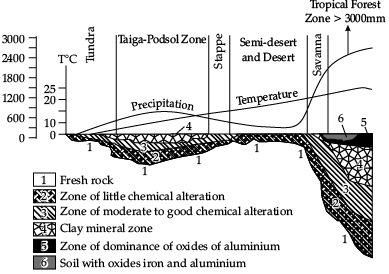 Q. According to the graph which of the following zone has zone of dominance of oxides of aluminium?
Q. According to the graph which of the following zone has zone of dominance of oxides of aluminium?- a)Taiga
- b)Sawanna
- c)Tropical
- d)Steppe
Correct answer is option 'C'. Can you explain this answer?
Direction: Read the Case Study given below and answer any three of the questions that follow:

Q. According to the graph which of the following zone has zone of dominance of oxides of aluminium?
a)
Taiga
b)
Sawanna
c)
Tropical
d)
Steppe
|
|
Kiran Mehta answered |
According to the graph Tropical zone has zone of dominance of oxides of aluminium.
Aluminum oxide is a white odorless crystalline powder. Aluminum oxide has a chemical formula Al2O3. It is amphoteric in nature, and is used in various chemical, industrial and commercial applications. It is considered an indirect additive used in food contact substances by the FDA.
Direction: Read the Case Study given below and answer any three of the questions that follow: Q. Clay mineral zone is found in:
Q. Clay mineral zone is found in:- a)Taiga
- b)Sawanna
- c)Tundra
- d)Steppe
Correct answer is option 'A'. Can you explain this answer?
Direction: Read the Case Study given below and answer any three of the questions that follow:

a)
Taiga
b)
Sawanna
c)
Tundra
d)
Steppe
|
|
Kiran Mehta answered |
Clay mineral zone is found in Taiga.
The taiga is a forest of the cold, subarctic region. The subarctic is an area of the Northern Hemisphere that lies just south of the Arctic Circle. The taiga lies between the tundra to the north and temperate forests to the south. The soil beneath the taiga often contains permafrost—a layer of permanently frozen soil.
Direction: Study the given graph carefully on rise of temperature globally and answer any three of the following questions: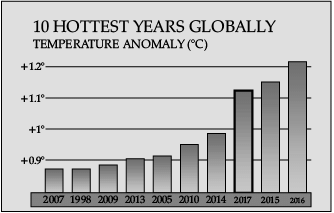 Q. In which years the temperatures increased by +0.9°C?
Q. In which years the temperatures increased by +0.9°C?- a)2007
- b)1998
- c)2009
- d)All of the above
Correct answer is option 'D'. Can you explain this answer?
Direction: Study the given graph carefully on rise of temperature globally and answer any three of the following questions:

a)
2007
b)
1998
c)
2009
d)
All of the above
|
|
Arun Yadav answered |
During 2007, 1998 and 2009 temperatures increased by +0.9°C.
Direction: Read the case study given below and answer any three of the questions that follow.The causes for climate change are many. They can be grouped into astronomical and terrestrial causes. The astronomical causes are the changes in solar output associated with sunspot activities. Sunspots are dark and cooler patches on the sun which increase and decrease in a cyclical manner. According to some meteorologists, when the number of sunspots increase, cooler and wetter weather and greater storminess occur. A decrease in sunspot numbers is associated with warm and drier conditions. Yet, these findings are not statistically significant. Another astronomical theory is Milankovitch oscillations, which infer cycles in the variations in the earth’s orbital characteristics around the sun, the wobbling of the earth and the changes in the earth’s axial tilt. All these alter the amount of insolation received from the sun, which in turn, might have a bearing on the climate. Volcanism is considered as another cause for climate change. Volcanic eruption throws up lots of aerosols into the atmosphere. These aerosols remain in the atmosphere for a considerable period of time reducing the sun’s radiation reaching the Earth’s surface. After the recent Pinatubo and El Cion volcanic eruptions, the average temperature of the earth fell to some extent for some years. The most important anthropogenic effect on the climate is the increasing trend in the concentration of greenhouse gases in the atmosphere which is likely to cause global warming.Q. Volcanic eruption throws up lots of _________into the atmosphere.- a)aerosols
- b)aerocells
- c)aeromoles
- d)None of the above
Correct answer is option 'A'. Can you explain this answer?
Direction: Read the case study given below and answer any three of the questions that follow.
The causes for climate change are many. They can be grouped into astronomical and terrestrial causes. The astronomical causes are the changes in solar output associated with sunspot activities. Sunspots are dark and cooler patches on the sun which increase and decrease in a cyclical manner. According to some meteorologists, when the number of sunspots increase, cooler and wetter weather and greater storminess occur. A decrease in sunspot numbers is associated with warm and drier conditions. Yet, these findings are not statistically significant. Another astronomical theory is Milankovitch oscillations, which infer cycles in the variations in the earth’s orbital characteristics around the sun, the wobbling of the earth and the changes in the earth’s axial tilt. All these alter the amount of insolation received from the sun, which in turn, might have a bearing on the climate. Volcanism is considered as another cause for climate change. Volcanic eruption throws up lots of aerosols into the atmosphere. These aerosols remain in the atmosphere for a considerable period of time reducing the sun’s radiation reaching the Earth’s surface. After the recent Pinatubo and El Cion volcanic eruptions, the average temperature of the earth fell to some extent for some years. The most important anthropogenic effect on the climate is the increasing trend in the concentration of greenhouse gases in the atmosphere which is likely to cause global warming.
Q. Volcanic eruption throws up lots of _________into the atmosphere.
a)
aerosols
b)
aerocells
c)
aeromoles
d)
None of the above
|
|
Rajesh Gupta answered |
Decrease of the ozone concentration following volcanic eruptions causes less UV absorption in stratosphere, which modifies the aerosol heating effect. The net effect of volcanic aerosols on the surface UV flux is to increase it, as the aero- sols backscatter less UV than the subsequent O3 depletion allows through.
Direction: Read the case study given below and answer any three of the questions that follow.The effect of global warming may not be uniform everywhere. Nevertheless, the adverse effect due to global warming will adversely affect the life supporting system. Rise in the sea level due to melting of glaciers and ice-caps and thermal expansion of the sea may inundate large parts of the coastal area and islands, leading to social problems. This is another cause for serious concern for the world community. Efforts have already been initiated to control the emission of GHGs and to arrest the trend towards global warming. Let us hope the world community responds to this challenge and adopts a lifestyle that leaves behind a livable world for the generations to come. Temperature data are available from the middle of the 19th century mostly for western Europe. The reference period for this study is 1961-90. The temperature anomalies for the earlier and later periods are estimated from the average temperature for the period 1961-90. The annual average near-surface air temperature of the world is approximately 14°C. The time series show anomalies of annual near surface temperature over land from 1856-2000, relative to the period 1961-90 as normal for the globe.Q. Efforts have already been initiated to control the emission of _________and to arrest the trend towards global warming.- a)CHCs
- b)GHGs
- c)HGHs
- d)HCHs
Correct answer is option 'B'. Can you explain this answer?
Direction: Read the case study given below and answer any three of the questions that follow.
The effect of global warming may not be uniform everywhere. Nevertheless, the adverse effect due to global warming will adversely affect the life supporting system. Rise in the sea level due to melting of glaciers and ice-caps and thermal expansion of the sea may inundate large parts of the coastal area and islands, leading to social problems. This is another cause for serious concern for the world community. Efforts have already been initiated to control the emission of GHGs and to arrest the trend towards global warming. Let us hope the world community responds to this challenge and adopts a lifestyle that leaves behind a livable world for the generations to come. Temperature data are available from the middle of the 19th century mostly for western Europe. The reference period for this study is 1961-90. The temperature anomalies for the earlier and later periods are estimated from the average temperature for the period 1961-90. The annual average near-surface air temperature of the world is approximately 14°C. The time series show anomalies of annual near surface temperature over land from 1856-2000, relative to the period 1961-90 as normal for the globe.
Q. Efforts have already been initiated to control the emission of _________and to arrest the trend towards global warming.
a)
CHCs
b)
GHGs
c)
HGHs
d)
HCHs
|
|
Ojasvi Mehta answered |
Greenhouse gas emissions are greenhouse gases vented to the Earth's atmosphere because of humans: the greenhouse effect of their 50 billion tons a year causes climate change. Most is carbon dioxide from burning fossil fuels: coal, oil, and natural gas.
Direction: Read the case study given below and answer any three of the questions that follow.The causes for climate change are many. They can be grouped into astronomical and terrestrial causes. The astronomical causes are the changes in solar output associated with sunspot activities. Sunspots are dark and cooler patches on the sun which increase and decrease in a cyclical manner. According to some meteorologists, when the number of sunspots increase, cooler and wetter weather and greater storminess occur. A decrease in sunspot numbers is associated with warm and drier conditions. Yet, these findings are not statistically significant. Another astronomical theory is Milankovitch oscillations, which infer cycles in the variations in the earth’s orbital characteristics around the sun, the wobbling of the earth and the changes in the earth’s axial tilt. All these alter the amount of insolation received from the sun, which in turn, might have a bearing on the climate. Volcanism is considered as another cause for climate change. Volcanic eruption throws up lots of aerosols into the atmosphere. These aerosols remain in the atmosphere for a considerable period of time reducing the sun’s radiation reaching the Earth’s surface. After the recent Pinatubo and El Cion volcanic eruptions, the average temperature of the earth fell to some extent for some years. The most important anthropogenic effect on the climate is the increasing trend in the concentration of greenhouse gases in the atmosphere which is likely to cause global warming.Q. What is the most important anthropogenic effect on the climates?- a)Concentration of greenhouse gases in the atmosphere
- b)Concentration of greenhouse gases in the lithosphere
- c)Concentration of greenhouse gases in the exosphere
- d)Concentration of greenhouse gases in the ionosphere
Correct answer is option 'A'. Can you explain this answer?
Direction: Read the case study given below and answer any three of the questions that follow.
The causes for climate change are many. They can be grouped into astronomical and terrestrial causes. The astronomical causes are the changes in solar output associated with sunspot activities. Sunspots are dark and cooler patches on the sun which increase and decrease in a cyclical manner. According to some meteorologists, when the number of sunspots increase, cooler and wetter weather and greater storminess occur. A decrease in sunspot numbers is associated with warm and drier conditions. Yet, these findings are not statistically significant. Another astronomical theory is Milankovitch oscillations, which infer cycles in the variations in the earth’s orbital characteristics around the sun, the wobbling of the earth and the changes in the earth’s axial tilt. All these alter the amount of insolation received from the sun, which in turn, might have a bearing on the climate. Volcanism is considered as another cause for climate change. Volcanic eruption throws up lots of aerosols into the atmosphere. These aerosols remain in the atmosphere for a considerable period of time reducing the sun’s radiation reaching the Earth’s surface. After the recent Pinatubo and El Cion volcanic eruptions, the average temperature of the earth fell to some extent for some years. The most important anthropogenic effect on the climate is the increasing trend in the concentration of greenhouse gases in the atmosphere which is likely to cause global warming.
Q. What is the most important anthropogenic effect on the climates?
a)
Concentration of greenhouse gases in the atmosphere
b)
Concentration of greenhouse gases in the lithosphere
c)
Concentration of greenhouse gases in the exosphere
d)
Concentration of greenhouse gases in the ionosphere
|
|
Rajesh Gupta answered |
Humans are increasingly influencing the climate and the earth's temperature by burning fossil fuels, cutting down forests and farming livestock. This adds enormous amounts of greenhouse gases to those naturally occurring in the atmosphere, increasing the greenhouse effect and global warming.
Direction: Read the Case Study given below and answer any three of the questions that follow: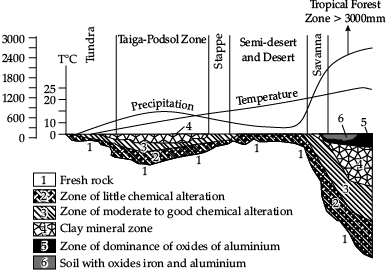 Q. According to the graph the precipitation is highest in which of the following forest zone?
Q. According to the graph the precipitation is highest in which of the following forest zone?- a)Tundra
- b)Desert
- c)Tropical
- d)Steppe
Correct answer is option 'C'. Can you explain this answer?
Direction: Read the Case Study given below and answer any three of the questions that follow:

Q. According to the graph the precipitation is highest in which of the following forest zone?
a)
Tundra
b)
Desert
c)
Tropical
d)
Steppe
|
|
Ojasvi Mehta answered |
The precipitation is highest in the Tropical forest zone.
Tropical rainforests are mainly located between the latitudes of 23.5°N (the Tropic of Cancer) and 23.5°S (the Tropic of Capricorn)—the tropics. Tropical rainforests are found in Central and South America, western and central Africa, western India, Southeast Asia, the island of New Guinea, and Australia.
Direction: Read the case study given below and answer any three of the questions that follow.The effect of global warming may not be uniform everywhere. Nevertheless, the adverse effect due to global warming will adversely affect the life supporting system. Rise in the sea level due to melting of glaciers and ice-caps and thermal expansion of the sea may inundate large parts of the coastal area and islands, leading to social problems. This is another cause for serious concern for the world community. Efforts have already been initiated to control the emission of GHGs and to arrest the trend towards global warming. Let us hope the world community responds to this challenge and adopts a lifestyle that leaves behind a livable world for the generations to come. Temperature data are available from the middle of the 19th century mostly for western Europe. The reference period for this study is 1961-90. The temperature anomalies for the earlier and later periods are estimated from the average temperature for the period 1961-90. The annual average near-surface air temperature of the world is approximately 14°C. The time series show anomalies of annual near surface temperature over land from 1856-2000, relative to the period 1961-90 as normal for the globe.Q. What is the annual average near-surface air temperature of the world?- a)Approximately 12°C
- b)Approximately 13°C
- c)Approximately 14°C
- d)Approximately 15°C
Correct answer is option 'C'. Can you explain this answer?
Direction: Read the case study given below and answer any three of the questions that follow.
The effect of global warming may not be uniform everywhere. Nevertheless, the adverse effect due to global warming will adversely affect the life supporting system. Rise in the sea level due to melting of glaciers and ice-caps and thermal expansion of the sea may inundate large parts of the coastal area and islands, leading to social problems. This is another cause for serious concern for the world community. Efforts have already been initiated to control the emission of GHGs and to arrest the trend towards global warming. Let us hope the world community responds to this challenge and adopts a lifestyle that leaves behind a livable world for the generations to come. Temperature data are available from the middle of the 19th century mostly for western Europe. The reference period for this study is 1961-90. The temperature anomalies for the earlier and later periods are estimated from the average temperature for the period 1961-90. The annual average near-surface air temperature of the world is approximately 14°C. The time series show anomalies of annual near surface temperature over land from 1856-2000, relative to the period 1961-90 as normal for the globe.
Q. What is the annual average near-surface air temperature of the world?
a)
Approximately 12°C
b)
Approximately 13°C
c)
Approximately 14°C
d)
Approximately 15°C
|
|
Ojasvi Mehta answered |
The global mean surface air temperature for that period was estimated to be 14°C (57°F), with an uncertainty of several tenths of a degree.
Direction: Study the given graph on global greenhouse gas emission and answer any three of the following questions: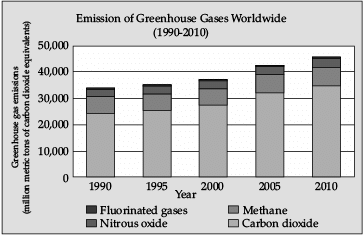 Q. How much Methane was emitted in 2005?
Q. How much Methane was emitted in 2005?- a)Between 30,000-40,000 metric tons
- b)Between 40,000-50,000 metric tons
- c)Between 60,000-70,000 metric tons
- d)Between 20,000-30,000 metric tons
Correct answer is option 'A'. Can you explain this answer?
Direction: Study the given graph on global greenhouse gas emission and answer any three of the following questions:

a)
Between 30,000-40,000 metric tons
b)
Between 40,000-50,000 metric tons
c)
Between 60,000-70,000 metric tons
d)
Between 20,000-30,000 metric tons
|
|
Arun Yadav answered |
Methane was emitted between 30,000-40,000 metric tons in 2005.
Methane is a powerful greenhouse gas emitted by human activities such as leakage from natural gas systems and the raising of livestock, as well as by natural sources such as wetlands. Methane is a short-lived climate pollutant with an atmospheric lifetime of around 12 years.
Direction: Read the case study given below and answer any three of the questions that follow.Different places on the earth’s surface receive different amounts of rainfall in a year and that too in different seasons. In general, as we proceed from the Equator towards the Poles, rainfall goes on decreasing steadily. The coastal areas of the world receive greater amounts of rainfall than the interior of the continents. The rainfall is more over the oceans than on the land masses of the world because of being great sources of water. Between the latitudes 350 and 400 N and S of the Equator, the rain is heavier on the eastern coasts and goes on decreasing towards the West. But, between 450 and 650 N and S of Equator, due to the westerlies, the rainfall is first received on the western margins of the continents and it goes on decreasing towards the East. Wherever mountains run parallel to the coast, the rain is greater on the coastal plain, on the windward side and it decreases towards the leeward side. On the basis of the total amount of annual precipitation, major precipitation regimes of the world are identified as follows: The equatorial belt, the windward slopes of the mountains along the western coasts in the cool temperate zone and the coastal areas of the monsoon land receive heavy rainfall of over 200 cm per annum. Interior continental areas receive moderate rainfall varying from 100 - 200 cm per annum. The coastal areas of the continents receive moderate amount of rainfall. The central parts of the tropical land and the eastern and interior parts of the temperate lands receive rainfall varying between 50 – 100 cm per annum. Areas lying in the rain shadow zone of the interior of the continents and high latitudes receive very low rainfall-less than 50 cm per annum. Seasonal distribution of rainfall provides an important aspect to judge its effectiveness. In some regions rainfall is distributed evenly throughout the year such as in the equatorial belt and in the western parts of cool temperate regions.Q. In general, as we proceed from the equator towards the poles, rainfall goes on ______ steadily.- a)decreasing
- b)increasing
- c)either increasing or decreasing
- d)neither increasing nor decreasing
Correct answer is option 'A'. Can you explain this answer?
Direction: Read the case study given below and answer any three of the questions that follow.
Different places on the earth’s surface receive different amounts of rainfall in a year and that too in different seasons. In general, as we proceed from the Equator towards the Poles, rainfall goes on decreasing steadily. The coastal areas of the world receive greater amounts of rainfall than the interior of the continents. The rainfall is more over the oceans than on the land masses of the world because of being great sources of water. Between the latitudes 350 and 400 N and S of the Equator, the rain is heavier on the eastern coasts and goes on decreasing towards the West. But, between 450 and 650 N and S of Equator, due to the westerlies, the rainfall is first received on the western margins of the continents and it goes on decreasing towards the East. Wherever mountains run parallel to the coast, the rain is greater on the coastal plain, on the windward side and it decreases towards the leeward side. On the basis of the total amount of annual precipitation, major precipitation regimes of the world are identified as follows: The equatorial belt, the windward slopes of the mountains along the western coasts in the cool temperate zone and the coastal areas of the monsoon land receive heavy rainfall of over 200 cm per annum. Interior continental areas receive moderate rainfall varying from 100 - 200 cm per annum. The coastal areas of the continents receive moderate amount of rainfall. The central parts of the tropical land and the eastern and interior parts of the temperate lands receive rainfall varying between 50 – 100 cm per annum. Areas lying in the rain shadow zone of the interior of the continents and high latitudes receive very low rainfall-less than 50 cm per annum. Seasonal distribution of rainfall provides an important aspect to judge its effectiveness. In some regions rainfall is distributed evenly throughout the year such as in the equatorial belt and in the western parts of cool temperate regions.
Q. In general, as we proceed from the equator towards the poles, rainfall goes on ______ steadily.
a)
decreasing
b)
increasing
c)
either increasing or decreasing
d)
neither increasing nor decreasing
|
|
Arun Yadav answered |
Different places on the earth's surface receive different amounts of rainfall in a year and that too in different seasons. In general, as we proceed from the equator towards the poles, rainfall goes on decreasing steadily.
Direction: Read the case study given below and answer any three of the questions that follow.The effect of global warming may not be uniform everywhere. Nevertheless, the adverse effect due to global warming will adversely affect the life supporting system. Rise in the sea level due to melting of glaciers and ice-caps and thermal expansion of the sea may inundate large parts of the coastal area and islands, leading to social problems. This is another cause for serious concern for the world community. Efforts have already been initiated to control the emission of GHGs and to arrest the trend towards global warming. Let us hope the world community responds to this challenge and adopts a lifestyle that leaves behind a livable world for the generations to come. Temperature data are available from the middle of the 19th century mostly for western Europe. The reference period for this study is 1961-90. The temperature anomalies for the earlier and later periods are estimated from the average temperature for the period 1961-90. The annual average near-surface air temperature of the world is approximately 14°C. The time series show anomalies of annual near surface temperature over land from 1856-2000, relative to the period 1961-90 as normal for the globe.Q. The adverse effect due to global warming will adversely affect the life ________ system.- a)supporting
- b)surviving
- c)sustaining
- d)suspension
Correct answer is option 'A'. Can you explain this answer?
Direction: Read the case study given below and answer any three of the questions that follow.
The effect of global warming may not be uniform everywhere. Nevertheless, the adverse effect due to global warming will adversely affect the life supporting system. Rise in the sea level due to melting of glaciers and ice-caps and thermal expansion of the sea may inundate large parts of the coastal area and islands, leading to social problems. This is another cause for serious concern for the world community. Efforts have already been initiated to control the emission of GHGs and to arrest the trend towards global warming. Let us hope the world community responds to this challenge and adopts a lifestyle that leaves behind a livable world for the generations to come. Temperature data are available from the middle of the 19th century mostly for western Europe. The reference period for this study is 1961-90. The temperature anomalies for the earlier and later periods are estimated from the average temperature for the period 1961-90. The annual average near-surface air temperature of the world is approximately 14°C. The time series show anomalies of annual near surface temperature over land from 1856-2000, relative to the period 1961-90 as normal for the globe.
Q. The adverse effect due to global warming will adversely affect the life ________ system.
a)
supporting
b)
surviving
c)
sustaining
d)
suspension
|
|
Kiran Mehta answered |
Global warming can result in many serious alterations to the environment, eventually impacting human health. It can also cause a rise in sea level, leading to the loss of coastal land, a change in precipitation patterns, increased risks of droughts and floods, and threats to biodiversity.
Direction: Study the given graph carefully on rise of temperature globally and answer any three of the following questions: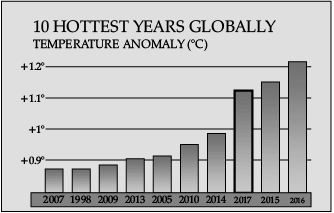 Q. Which was the last year of the 20th century to experience increase in temperature by +1°C?
Q. Which was the last year of the 20th century to experience increase in temperature by +1°C?- a)1998
- b)2007
- c)2009
- d)2013
Correct answer is option 'A'. Can you explain this answer?
Direction: Study the given graph carefully on rise of temperature globally and answer any three of the following questions:

a)
1998
b)
2007
c)
2009
d)
2013
|
|
Arun Yadav answered |
1998 was the last year of the 20th century to experience increase in temperature by +1°C.
Direction: Study the given graph carefully on rise of temperature globally and answer any three of the following questions: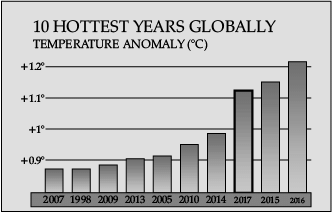 Q. The temperature rose _______ globally by 2016.
Q. The temperature rose _______ globally by 2016.- a)More than +1.2°C
- b)Less than –1.2°C
- c)More than +1.1°C
- d)Less than –1.1°C
Correct answer is option 'A'. Can you explain this answer?
Direction: Study the given graph carefully on rise of temperature globally and answer any three of the following questions:

a)
More than +1.2°C
b)
Less than –1.2°C
c)
More than +1.1°C
d)
Less than –1.1°C
|
|
Arun Yadav answered |
The temperature rose More than +1.2°C globally by 2016.
Direction: Read the case study given below and answer any three of the questions that follow.The effect of global warming may not be uniform everywhere. Nevertheless, the adverse effect due to global warming will adversely affect the life supporting system. Rise in the sea level due to melting of glaciers and ice-caps and thermal expansion of the sea may inundate large parts of the coastal area and islands, leading to social problems. This is another cause for serious concern for the world community. Efforts have already been initiated to control the emission of GHGs and to arrest the trend towards global warming. Let us hope the world community responds to this challenge and adopts a lifestyle that leaves behind a livable world for the generations to come. Temperature data are available from the middle of the 19th century mostly for western Europe. The reference period for this study is 1961-90. The temperature anomalies for the earlier and later periods are estimated from the average temperature for the period 1961-90. The annual average near-surface air temperature of the world is approximately 14°C. The time series show anomalies of annual near surface temperature over land from 1856-2000, relative to the period 1961-90 as normal for the globe.Q. The temperature anomalies for the earlier and later periods are estimated from the average temperature for the period:- a)1961-90
- b)1972-91
- c)1960-91
- d)1971-90
Correct answer is option 'A'. Can you explain this answer?
Direction: Read the case study given below and answer any three of the questions that follow.
The effect of global warming may not be uniform everywhere. Nevertheless, the adverse effect due to global warming will adversely affect the life supporting system. Rise in the sea level due to melting of glaciers and ice-caps and thermal expansion of the sea may inundate large parts of the coastal area and islands, leading to social problems. This is another cause for serious concern for the world community. Efforts have already been initiated to control the emission of GHGs and to arrest the trend towards global warming. Let us hope the world community responds to this challenge and adopts a lifestyle that leaves behind a livable world for the generations to come. Temperature data are available from the middle of the 19th century mostly for western Europe. The reference period for this study is 1961-90. The temperature anomalies for the earlier and later periods are estimated from the average temperature for the period 1961-90. The annual average near-surface air temperature of the world is approximately 14°C. The time series show anomalies of annual near surface temperature over land from 1856-2000, relative to the period 1961-90 as normal for the globe.
Q. The temperature anomalies for the earlier and later periods are estimated from the average temperature for the period:
a)
1961-90
b)
1972-91
c)
1960-91
d)
1971-90
|
|
Ojasvi Mehta answered |
- The temperature anomalies for the earlier and later periods are estimated from the average temperature for the period 1961-90.
- A temperature anomaly is the departure from the average temperature, positive or negative, over a certain period (day, week, month or year). In standard usage, the normal average temperature would be calculated over a period of at least 30 years over an homogeneous geographic region.
Direction: Study the given graph carefully on rise of temperature globally and answer any three of the following questions: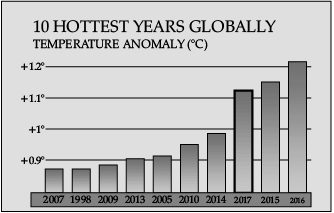 Q. How much did the temperature rise by 2017?
Q. How much did the temperature rise by 2017?- a)+1.1°C
- b)More than +1.1°C
- c)Less than +1.1°C
- d)None of the Above
Correct answer is option 'B'. Can you explain this answer?
Direction: Study the given graph carefully on rise of temperature globally and answer any three of the following questions:

a)
+1.1°C
b)
More than +1.1°C
c)
Less than +1.1°C
d)
None of the Above
|
|
Naina Sharma answered |
Temperature raised by More than +1.1°C in 2017.
Direction: Read the case study given below and answer any three of the questions that follow.Different places on the earth’s surface receive different amounts of rainfall in a year and that too in different seasons. In general, as we proceed from the Equator towards the Poles, rainfall goes on decreasing steadily. The coastal areas of the world receive greater amounts of rainfall than the interior of the continents. The rainfall is more over the oceans than on the land masses of the world because of being great sources of water. Between the latitudes 350 and 400 N and S of the Equator, the rain is heavier on the eastern coasts and goes on decreasing towards the West. But, between 450 and 650 N and S of Equator, due to the westerlies, the rainfall is first received on the western margins of the continents and it goes on decreasing towards the East. Wherever mountains run parallel to the coast, the rain is greater on the coastal plain, on the windward side and it decreases towards the leeward side. On the basis of the total amount of annual precipitation, major precipitation regimes of the world are identified as follows: The equatorial belt, the windward slopes of the mountains along the western coasts in the cool temperate zone and the coastal areas of the monsoon land receive heavy rainfall of over 200 cm per annum. Interior continental areas receive moderate rainfall varying from 100 - 200 cm per annum. The coastal areas of the continents receive moderate amount of rainfall. The central parts of the tropical land and the eastern and interior parts of the temperate lands receive rainfall varying between 50 – 100 cm per annum. Areas lying in the rain shadow zone of the interior of the continents and high latitudes receive very low rainfall-less than 50 cm per annum. Seasonal distribution of rainfall provides an important aspect to judge its effectiveness. In some regions rainfall is distributed evenly throughout the year such as in the equatorial belt and in the western parts of cool temperate regions.Q. In _________, the windward slopes of the mountains along the western coasts in the cool temperate zone and the coastal areas of the monsoon land receive heavy rainfall.- a)interior continental areas
- b)temperate lands
- c)coastal areas
- d)equatorial belt
Correct answer is option 'D'. Can you explain this answer?
Direction: Read the case study given below and answer any three of the questions that follow.
Different places on the earth’s surface receive different amounts of rainfall in a year and that too in different seasons. In general, as we proceed from the Equator towards the Poles, rainfall goes on decreasing steadily. The coastal areas of the world receive greater amounts of rainfall than the interior of the continents. The rainfall is more over the oceans than on the land masses of the world because of being great sources of water. Between the latitudes 350 and 400 N and S of the Equator, the rain is heavier on the eastern coasts and goes on decreasing towards the West. But, between 450 and 650 N and S of Equator, due to the westerlies, the rainfall is first received on the western margins of the continents and it goes on decreasing towards the East. Wherever mountains run parallel to the coast, the rain is greater on the coastal plain, on the windward side and it decreases towards the leeward side. On the basis of the total amount of annual precipitation, major precipitation regimes of the world are identified as follows: The equatorial belt, the windward slopes of the mountains along the western coasts in the cool temperate zone and the coastal areas of the monsoon land receive heavy rainfall of over 200 cm per annum. Interior continental areas receive moderate rainfall varying from 100 - 200 cm per annum. The coastal areas of the continents receive moderate amount of rainfall. The central parts of the tropical land and the eastern and interior parts of the temperate lands receive rainfall varying between 50 – 100 cm per annum. Areas lying in the rain shadow zone of the interior of the continents and high latitudes receive very low rainfall-less than 50 cm per annum. Seasonal distribution of rainfall provides an important aspect to judge its effectiveness. In some regions rainfall is distributed evenly throughout the year such as in the equatorial belt and in the western parts of cool temperate regions.
Q. In _________, the windward slopes of the mountains along the western coasts in the cool temperate zone and the coastal areas of the monsoon land receive heavy rainfall.
a)
interior continental areas
b)
temperate lands
c)
coastal areas
d)
equatorial belt
|
|
Arun Yadav answered |
The equatorial belt, the windward slopes of the mountains along the western coasts in the cool temperate zone and the coastal areas of the monsoon land receive heavy rainfall of over 200 cm per annum.
Direction: Study the given graph on global greenhouse gas emission and answer any three of the following questions: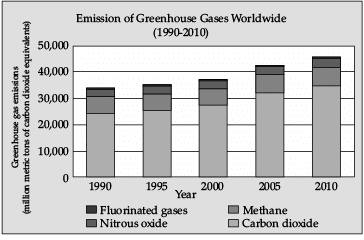 Q. Which gas had the minimum emission in 1990?
Q. Which gas had the minimum emission in 1990?- a)Nitrous Methane
- b)Methane
- c)Fluorinated gases
- d)Carbon dioxide
Correct answer is option 'C'. Can you explain this answer?
Direction: Study the given graph on global greenhouse gas emission and answer any three of the following questions:

a)
Nitrous Methane
b)
Methane
c)
Fluorinated gases
d)
Carbon dioxide
|
|
Arun Yadav answered |
Fluorinated gases had the minimum emission in 1990.
Fluorinated gases (F-gases) are man-made gases that can stay in the atmosphere for centuries and contribute to a global greenhouse effect. F-gases are a subgroup of the halogenated gases, the majority of which are halocarbons that include fluorine, but do not include chlorine, bromine, or iodine.
Direction: Read the case study given below and answer any three of the questions that follow.Different places on the earth’s surface receive different amounts of rainfall in a year and that too in different seasons. In general, as we proceed from the Equator towards the Poles, rainfall goes on decreasing steadily. The coastal areas of the world receive greater amounts of rainfall than the interior of the continents. The rainfall is more over the oceans than on the land masses of the world because of being great sources of water. Between the latitudes 350 and 400 N and S of the Equator, the rain is heavier on the eastern coasts and goes on decreasing towards the West. But, between 450 and 650 N and S of Equator, due to the westerlies, the rainfall is first received on the western margins of the continents and it goes on decreasing towards the East. Wherever mountains run parallel to the coast, the rain is greater on the coastal plain, on the windward side and it decreases towards the leeward side. On the basis of the total amount of annual precipitation, major precipitation regimes of the world are identified as follows: The equatorial belt, the windward slopes of the mountains along the western coasts in the cool temperate zone and the coastal areas of the monsoon land receive heavy rainfall of over 200 cm per annum. Interior continental areas receive moderate rainfall varying from 100 - 200 cm per annum. The coastal areas of the continents receive moderate amount of rainfall. The central parts of the tropical land and the eastern and interior parts of the temperate lands receive rainfall varying between 50 – 100 cm per annum. Areas lying in the rain shadow zone of the interior of the continents and high latitudes receive very low rainfall-less than 50 cm per annum. Seasonal distribution of rainfall provides an important aspect to judge its effectiveness. In some regions rainfall is distributed evenly throughout the year such as in the equatorial belt and in the western parts of cool temperate regions.Q. Between the latitudes 350 and 400 N and S of the Equator, the rain is heavier on the ________ coasts.- a)eastern
- b)western
- c)northern
- d)southern
Correct answer is option 'A'. Can you explain this answer?
Direction: Read the case study given below and answer any three of the questions that follow.
Different places on the earth’s surface receive different amounts of rainfall in a year and that too in different seasons. In general, as we proceed from the Equator towards the Poles, rainfall goes on decreasing steadily. The coastal areas of the world receive greater amounts of rainfall than the interior of the continents. The rainfall is more over the oceans than on the land masses of the world because of being great sources of water. Between the latitudes 350 and 400 N and S of the Equator, the rain is heavier on the eastern coasts and goes on decreasing towards the West. But, between 450 and 650 N and S of Equator, due to the westerlies, the rainfall is first received on the western margins of the continents and it goes on decreasing towards the East. Wherever mountains run parallel to the coast, the rain is greater on the coastal plain, on the windward side and it decreases towards the leeward side. On the basis of the total amount of annual precipitation, major precipitation regimes of the world are identified as follows: The equatorial belt, the windward slopes of the mountains along the western coasts in the cool temperate zone and the coastal areas of the monsoon land receive heavy rainfall of over 200 cm per annum. Interior continental areas receive moderate rainfall varying from 100 - 200 cm per annum. The coastal areas of the continents receive moderate amount of rainfall. The central parts of the tropical land and the eastern and interior parts of the temperate lands receive rainfall varying between 50 – 100 cm per annum. Areas lying in the rain shadow zone of the interior of the continents and high latitudes receive very low rainfall-less than 50 cm per annum. Seasonal distribution of rainfall provides an important aspect to judge its effectiveness. In some regions rainfall is distributed evenly throughout the year such as in the equatorial belt and in the western parts of cool temperate regions.
Q. Between the latitudes 350 and 400 N and S of the Equator, the rain is heavier on the ________ coasts.
a)
eastern
b)
western
c)
northern
d)
southern
|
|
Arun Yadav answered |
The rainfall is more over the oceans than on the landmasses of the world because of being great sources of water. Between the latitudes 350 and 400 N and S of the equator, the rain is heavier on the eastern coasts and goes on decreasing towards the west.
Direction: Study the given graph on global greenhouse gas emission and answer any three of the following questions: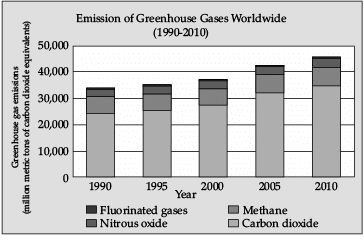 Q. How much Nitrous Oxide was emitted in 1990?
Q. How much Nitrous Oxide was emitted in 1990?- a)Between 30,000 to 35,000 tons
- b)Between 35,000 to 40,000 tons
- c)Between 40,000 to 45,000 tons
- d)None of the Above
Correct answer is option 'A'. Can you explain this answer?
Direction: Study the given graph on global greenhouse gas emission and answer any three of the following questions:

a)
Between 30,000 to 35,000 tons
b)
Between 35,000 to 40,000 tons
c)
Between 40,000 to 45,000 tons
d)
None of the Above
|
|
Arun Yadav answered |
Nitrous Oxide was emitted between 30,000 to 35,000 tons in 1990.
Nitrous oxide is emitted when fuels are burned. The amount of N2O emitted from burning fuels depends on the type of fuel and combustion technology, maintenance, and operating practices.
Direction: Study the given graph on global greenhouse gas emission and answer any three of the following questions: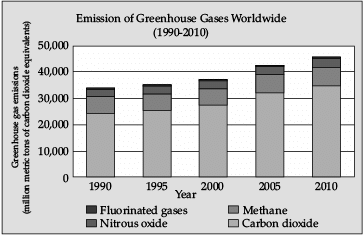 Q. Which gas had the maximum emission in 2010?
Q. Which gas had the maximum emission in 2010?- a)Methane
- b)Carbon dioxide
- c)Fluorinated gases
- d)None of the above
Correct answer is option 'B'. Can you explain this answer?
Direction: Study the given graph on global greenhouse gas emission and answer any three of the following questions:

a)
Methane
b)
Carbon dioxide
c)
Fluorinated gases
d)
None of the above
|
|
Arun Yadav answered |
Carbon dioxide had the maximum emission in 2010.
Carbon dioxide emissions or CO2 emissions are emissions stemming from the burning of fossil fuels and the manufacture of cement; they include carbon dioxide produced during consumption of solid, liquid, and gas fuels as well as gas flaring.
Direction: Read the Case Study given below and answer any three of the questions that follow: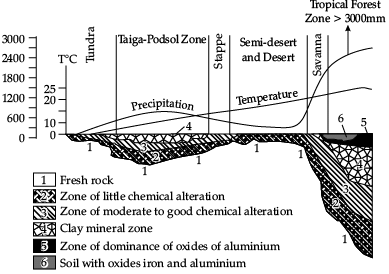 Q. According to the graph which of the following forest zone has the highest temperature?
Q. According to the graph which of the following forest zone has the highest temperature?- a)Taiga
- b)Desert
- c)Tropical
- d)Steppe
Correct answer is option 'C'. Can you explain this answer?
Direction: Read the Case Study given below and answer any three of the questions that follow:

a)
Taiga
b)
Desert
c)
Tropical
d)
Steppe
|
|
Kiran Mehta answered |
According to the graph Tropical forest zone has the highest temperature.
A tropical rainforest climate is typically hot, very humid and wet. The highest temperature ever recorded was 103 °F (39 °C) at San Lorenzo, while the lowest temperature ever recorded was 38 °F (3 °C) at Aibonito.
Direction: Read the case study given below and answer any three of the questions that follow.Different places on the earth’s surface receive different amounts of rainfall in a year and that too in different seasons. In general, as we proceed from the Equator towards the Poles, rainfall goes on decreasing steadily. The coastal areas of the world receive greater amounts of rainfall than the interior of the continents. The rainfall is more over the oceans than on the land masses of the world because of being great sources of water. Between the latitudes 350 and 400 N and S of the Equator, the rain is heavier on the eastern coasts and goes on decreasing towards the West. But, between 450 and 650 N and S of Equator, due to the westerlies, the rainfall is first received on the western margins of the continents and it goes on decreasing towards the East. Wherever mountains run parallel to the coast, the rain is greater on the coastal plain, on the windward side and it decreases towards the leeward side. On the basis of the total amount of annual precipitation, major precipitation regimes of the world are identified as follows: The equatorial belt, the windward slopes of the mountains along the western coasts in the cool temperate zone and the coastal areas of the monsoon land receive heavy rainfall of over 200 cm per annum. Interior continental areas receive moderate rainfall varying from 100 - 200 cm per annum. The coastal areas of the continents receive moderate amount of rainfall. The central parts of the tropical land and the eastern and interior parts of the temperate lands receive rainfall varying between 50 – 100 cm per annum. Areas lying in the rain shadow zone of the interior of the continents and high latitudes receive very low rainfall-less than 50 cm per annum. Seasonal distribution of rainfall provides an important aspect to judge its effectiveness. In some regions rainfall is distributed evenly throughout the year such as in the equatorial belt and in the western parts of cool temperate regions.Q. The central parts of the tropical land and the eastern and interior parts of the temperate lands receive rainfall varying between:- a)25 - 50 cm per annum
- b)50 - 100 cm per annum
- c)100 - 150 cm per annum
- d)150 - 200 cm per annum
Correct answer is option 'B'. Can you explain this answer?
Direction: Read the case study given below and answer any three of the questions that follow.
Different places on the earth’s surface receive different amounts of rainfall in a year and that too in different seasons. In general, as we proceed from the Equator towards the Poles, rainfall goes on decreasing steadily. The coastal areas of the world receive greater amounts of rainfall than the interior of the continents. The rainfall is more over the oceans than on the land masses of the world because of being great sources of water. Between the latitudes 350 and 400 N and S of the Equator, the rain is heavier on the eastern coasts and goes on decreasing towards the West. But, between 450 and 650 N and S of Equator, due to the westerlies, the rainfall is first received on the western margins of the continents and it goes on decreasing towards the East. Wherever mountains run parallel to the coast, the rain is greater on the coastal plain, on the windward side and it decreases towards the leeward side. On the basis of the total amount of annual precipitation, major precipitation regimes of the world are identified as follows: The equatorial belt, the windward slopes of the mountains along the western coasts in the cool temperate zone and the coastal areas of the monsoon land receive heavy rainfall of over 200 cm per annum. Interior continental areas receive moderate rainfall varying from 100 - 200 cm per annum. The coastal areas of the continents receive moderate amount of rainfall. The central parts of the tropical land and the eastern and interior parts of the temperate lands receive rainfall varying between 50 – 100 cm per annum. Areas lying in the rain shadow zone of the interior of the continents and high latitudes receive very low rainfall-less than 50 cm per annum. Seasonal distribution of rainfall provides an important aspect to judge its effectiveness. In some regions rainfall is distributed evenly throughout the year such as in the equatorial belt and in the western parts of cool temperate regions.
Q. The central parts of the tropical land and the eastern and interior parts of the temperate lands receive rainfall varying between:
a)
25 - 50 cm per annum
b)
50 - 100 cm per annum
c)
100 - 150 cm per annum
d)
150 - 200 cm per annum
|
|
Kiran Mehta answered |
The central parts of the tropical land and the eastern and interior parts of the temperate lands receive rainfall varying between 50 – 100 cm per annum.
Chapter doubts & questions for World Climate and Climate Change - Geography Class 11 2025 is part of Humanities/Arts exam preparation. The chapters have been prepared according to the Humanities/Arts exam syllabus. The Chapter doubts & questions, notes, tests & MCQs are made for Humanities/Arts 2025 Exam. Find important definitions, questions, notes, meanings, examples, exercises, MCQs and online tests here.
Chapter doubts & questions of World Climate and Climate Change - Geography Class 11 in English & Hindi are available as part of Humanities/Arts exam.
Download more important topics, notes, lectures and mock test series for Humanities/Arts Exam by signing up for free.
Geography Class 11
70 videos|289 docs|44 tests
|

Contact Support
Our team is online on weekdays between 10 AM - 7 PM
Typical reply within 3 hours
|
Free Exam Preparation
at your Fingertips!
Access Free Study Material - Test Series, Structured Courses, Free Videos & Study Notes and Prepare for Your Exam With Ease

 Join the 10M+ students on EduRev
Join the 10M+ students on EduRev
|

|
Create your account for free
OR
Forgot Password
OR
Signup on EduRev and stay on top of your study goals
10M+ students crushing their study goals daily









